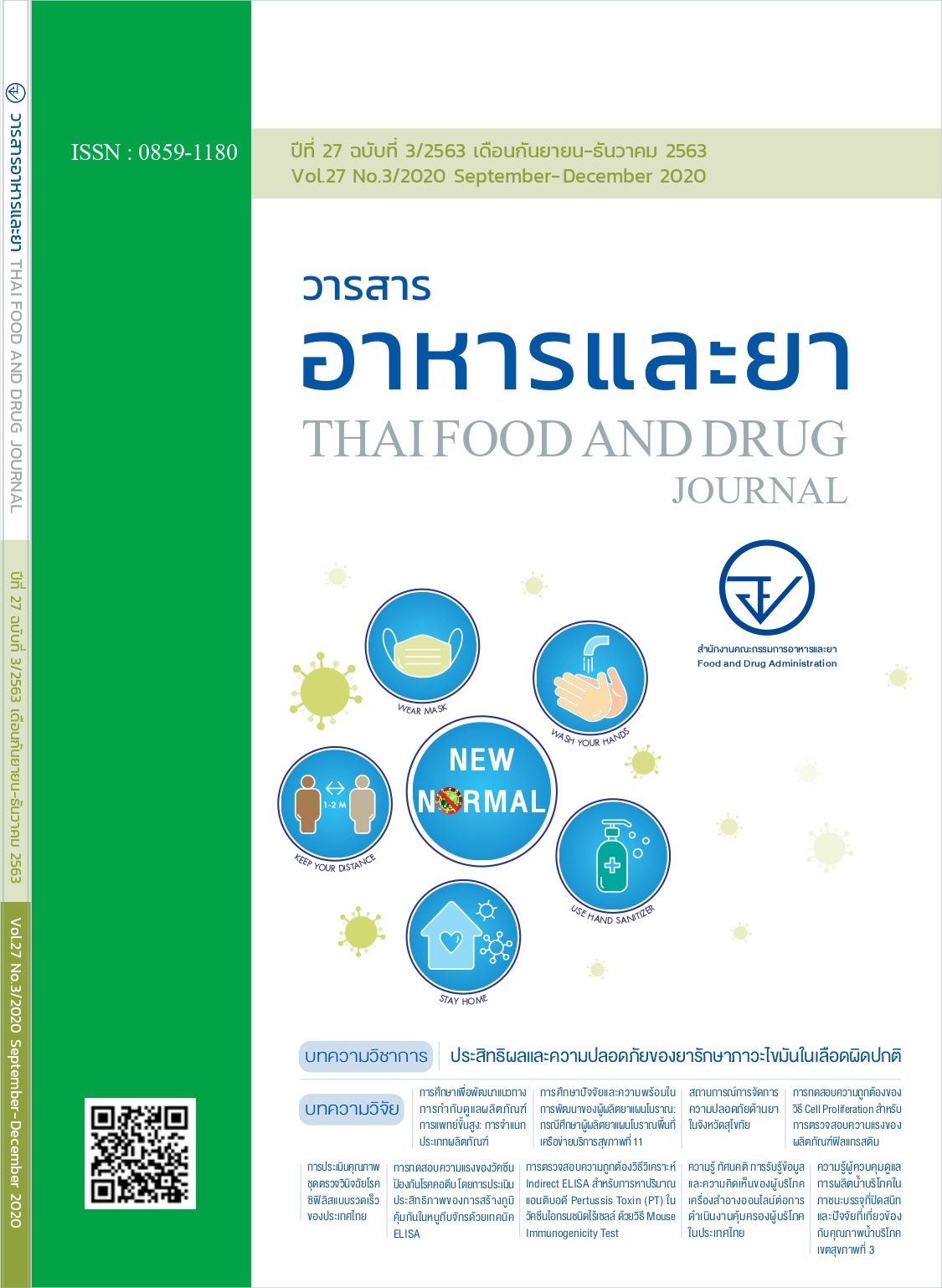การทดสอบความแรงของวัคซีนป้องกันโรคคอตีบ โดยการประเมินประสิทธิภาพ ของการสร้างภูมิคุ้มกันในหนูถีบจักรด้วยเทคนิค ELISA
Main Article Content
บทคัดย่อ
การทดสอบความแรงของแอนติเจนหรือสารกระตุ้นภูมิคุ้มกันเป็นกระบวนการที่สำคัญของการประเมิน
ประสิทธิภาพวัคซีน ปัจจุบันประเทศไทยทดสอบความแรงของวัคซีนป้องกันโรคคอตีบโดยวิธี neutralization test
(US potency method) ในหนูตะเภา ซึ่งได้ผลการทดสอบเป็นค่าประมาณโดยไม่สามารถระบุเป็นค่าที่แน่นอนได้
การพัฒนาวิธีการตรวจวิเคราะห์ภูมิคุมกันในหนูถีบจักรด้วยเทคนิค ELISA ซึ่งให้ผลการทดสอบมีค่าเชิงปริมาณ
ในหน่วย International Unit (IU) สามารถนำผลมาวิเคราะห์แนวโน้มเทียบกับผลการทดสอบของผู้ผลิตได้ จึงเป็น
วิธีทางเลือกเพื่อทดแทนวิธีดั้งเดิม จากการตรวจสอบความถูกต้องของวิธีพบว่า ทุกผลการทดสอบที่ระดับความเชื่อมั่น
ร้อยละ 95 ของทุกค่า ความแรงที่ได้มีค่าอยู่ระหว่างร้อยละ 50 ถึง 200 ตามข้อกำหนดขององค์การอนามัยโลก
ค่าระดับภูมิคุมกันของหนูถีบจักรต่อวัคซีนตัวอย่างจะแปรผันตามระดับความเจือจางของวัคซีนในลักษณะเป็น
เส้นตรง ขนานกับค่าระดับภูมิคุ้มกันของหนูถีบจักรต่อวัคซีนมาตรฐาน ผลการทดสอบซํ้าในวันเดียวกัน 3 ครั้ง
มีค่าเบี่ยงเบนมาตรฐาน และค่าสัมประสิทธิ์ความแปรปรวน (%CV) เท่ากับร้อยละ 1.15 และ 13.81 ตามลำดับ
ผลการทดสอบระหว่างวัน พบว่า ค่าเบี่ยงเบนมาตรฐานเท่ากับ 1.89 และค่า %CV เท่ากับ 8.42 ส่วนผลการทดสอบ
โดยผู้วิเคราะห์ 2 คน มีค่าเบี่ยงเบนมาตรฐานเท่ากับ 1.07 และค่า %CV เท่ากับ 7.03 และไม่พบว่ามีค่าแตกต่างกัน
อย่างมีนัยสำคัญทางสถิติ (p>0.05) จากการศึกษาดังกล่าวนี้แสดงให้เห็นวิธีที่ให้ผลการทดสอบที่มีประสิทธิภาพ
จึงเป็นอีกวิธีมาตรฐานทางเลือกในการทดสอบค่าความแรงของวัคซีนป้องกันโรคคอตีบเพื่อประเมินประสิทธิภาพ
ของวัคซีน ซึ่งจะสามารถลดระยะเวลาการทดสอบ และลดความเสี่ยงจากการสัมผัสพิษ (toxin) ที่จะเกิดขึ้นใน
ขั้นตอน neutralization ได้


